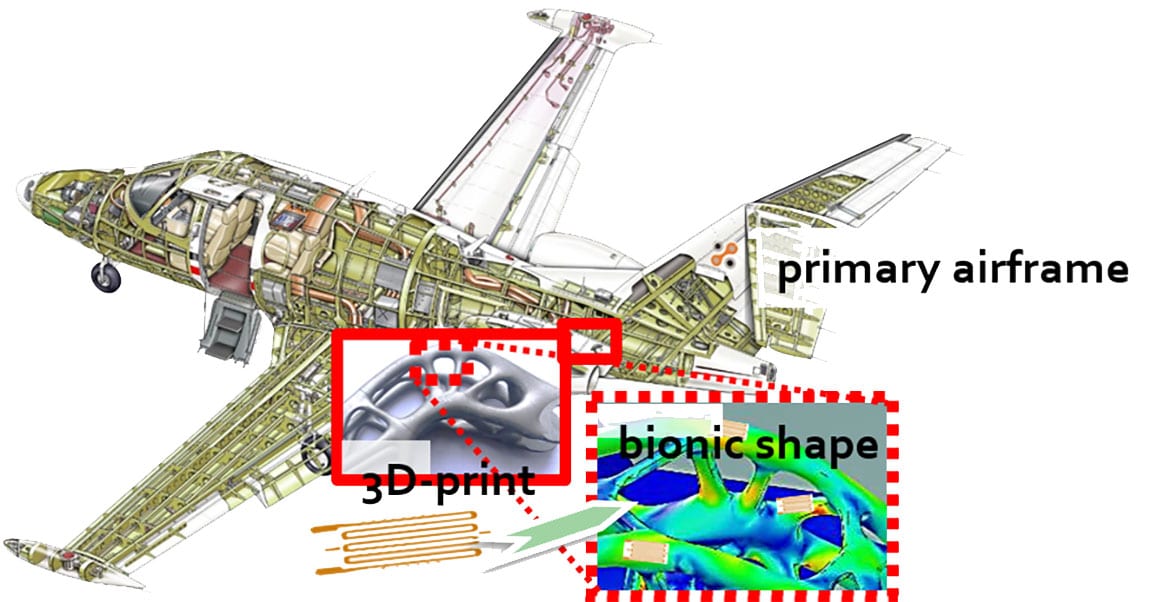- About us
- Research expertise
- DIGITAL – Institut für Digitale Technologien
- MATERIALS – Institut für Sensorik, Photonik und Fertigungstechnologien
- ROBOTICS – Institut für Robotik und Flexible Produktion
- COREMED – Zentrum für Regenerative Medizin und Präzisionsmedizin
- HEALTH – Institut für Biomedizinische Forschung und Technologien
- LIFE – Institut für Klima, Energiesysteme und Gesellschaft
- POLICIES – Institut für Wirtschafts-, Sozial und Innovationsforschung
- Business areas
- Products & services
- Research infrastructure
- Beteiligungen
- Career
- Aktuelles
- Publications
- Kontakt zu uns
3D-Strain-Sense: Health Monitoring using Sensors on Bionic Structural Components
Duration:
04/2023
—
03/2026
Total Time:
3 Years

Robot-supported printing of electronic components on 3D surfaces, Photo: JOANNEUM RESEARCH
The Project
How can the functions of aircraft surfaces be tested?
To reduce emissions, weight-optimized, bionic components from additive manufacturing (3D printing) will be used in aircraft in the future. In addition, sensors for condition monitoring will be printed directly onto their surfaces. The special feature here is that the printing takes place on free-form surfaces with multiple curvatures. A serial manipulator is used for this, which moves the component precisely under the stationary print head.
Our activities within the project
In contrast to conventional methods with flat print images, the printing process on three-dimensional, multi-curved surfaces requires additional degrees of freedom. We develop the path planning, collision control and synchronisation with the print head and program the serial manipulator in a test setup of the entire system.
Research group
Downloads
Sponsors
FFG
Project Partners
alphacam austria GmbH
Mali AIR Luftverkehr GmbH
Materials Center Leoben Forschung GmbH
Sinus Pro GmbH
Project Details
The aim is to develop solutions for a more sustainable aircraft industry using additive manufacturing and condition monitoring of components. In detail, this means that experts from SMEs and R&D institutes are researching an innovative method of applying resistive sensors to convex and concave free-form surfaces using functional direct-to-shape printing with robot-controlled inkjet printing. A special aspect of this project is that, for the first time, the parts to be printed are moved in the vertical printing direction. This should lead to greater precision and reproducibility compared to tilted print heads.
What is the background?
Weight reduction is a decisive factor in reducing emissions in the aircraft industry. For many components, significant material savings with the same load-bearing capacity can be achieved, for example, through bionic optimization. Such geometries are often not economically producible with conventional manufacturing methods. However, additive manufacturing makes it possible. In addition to weight optimisation also aircraft maintenance intervals and service times should be improved. Structural health monitoring (SMH) techniques, i.e., condition monitoring of critical components, can help to prevent the unnecessary replacement of perfectly functional parts.
As a first step, demonstrators for additional fuel tank mounts in small aircraft are being developed and subjected to scientifically based fatigue testing and failure analysis on bionic demonstrators in the laboratory. This process creates an important dataset for validating the process simulation, which is essential for the further development, especially for topology-optimized components with difficult heat distribution.
The developed demonstrators also serve as a basis for the long-term integration of Structural Health Monitoring (SHM) into the aircraft structure. This should enable the integration of 3D printing and bionic lightweight components into the main structure by 2035.
Projektbeteiligte
Similar Projects
SHAPING THE FUTURE
TOGETHER
JOANNEUM RESEARCH provides innovation and technology services in the field of applied research. As a research company working on behalf of various federal provinces and regions in Austria, our expertise shapes the development of our modern society and economy – sustainably, and always with a focus on people. As a multidisciplinary team working in a flexible set-up that fosters innovation, we always live up to the highest social and scientific standards.
CONTACT
JOANNEUM RESEARCH
FORSCHUNGSGESELLSCHAFT MBH
TOGETHER | Alle Rechte vorbehalten. Created by idlab media GmbH & Lorem Ipsum web.solutions GmbH


